coolant temperature MAZDA MODEL MAZDASPEED 3 2007 Owners Manual (in English)
[x] Cancel search | Manufacturer: MAZDA, Model Year: 2007, Model line: MODEL MAZDASPEED 3, Model: MAZDA MODEL MAZDASPEED 3 2007Pages: 402, PDF Size: 7.08 MB
Page 154 of 402
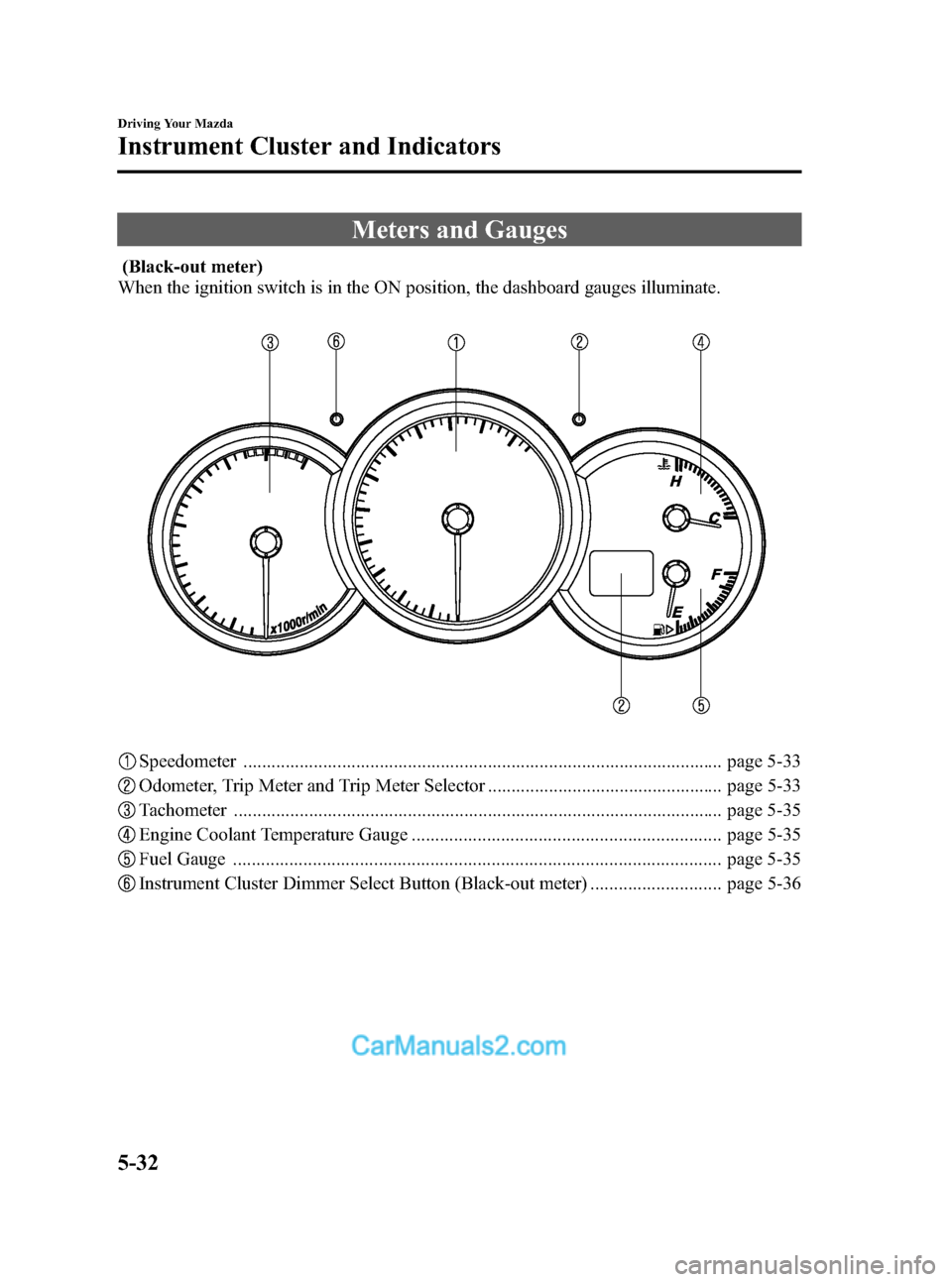
Black plate (154,1)
Meters and Gauges
(Black-out meter)
When the ignition switch is in the ON position, the dashboard gauges illuminate.
Speedometer ...................................................................................................... page 5-33
Odometer, Trip Meter and Trip Meter Selector .................................................. page 5-33
Tachometer ........................................................................................................ page 5-35
Engine Coolant Temperature Gauge .................................................................. page 5-35
Fuel Gauge ........................................................................................................ page 5-35
Instrument Cluster Dimmer Select Button (Black-out meter) ............................ page 5-36
5-32
Driving Your Mazda
Instrument Cluster and Indicators
Mazda3_8V66-EA-06F_Edition3 Page154
Wednesday, August 23 2006 11:19 AM
Form No.8V66-EA-06F
Page 157 of 402
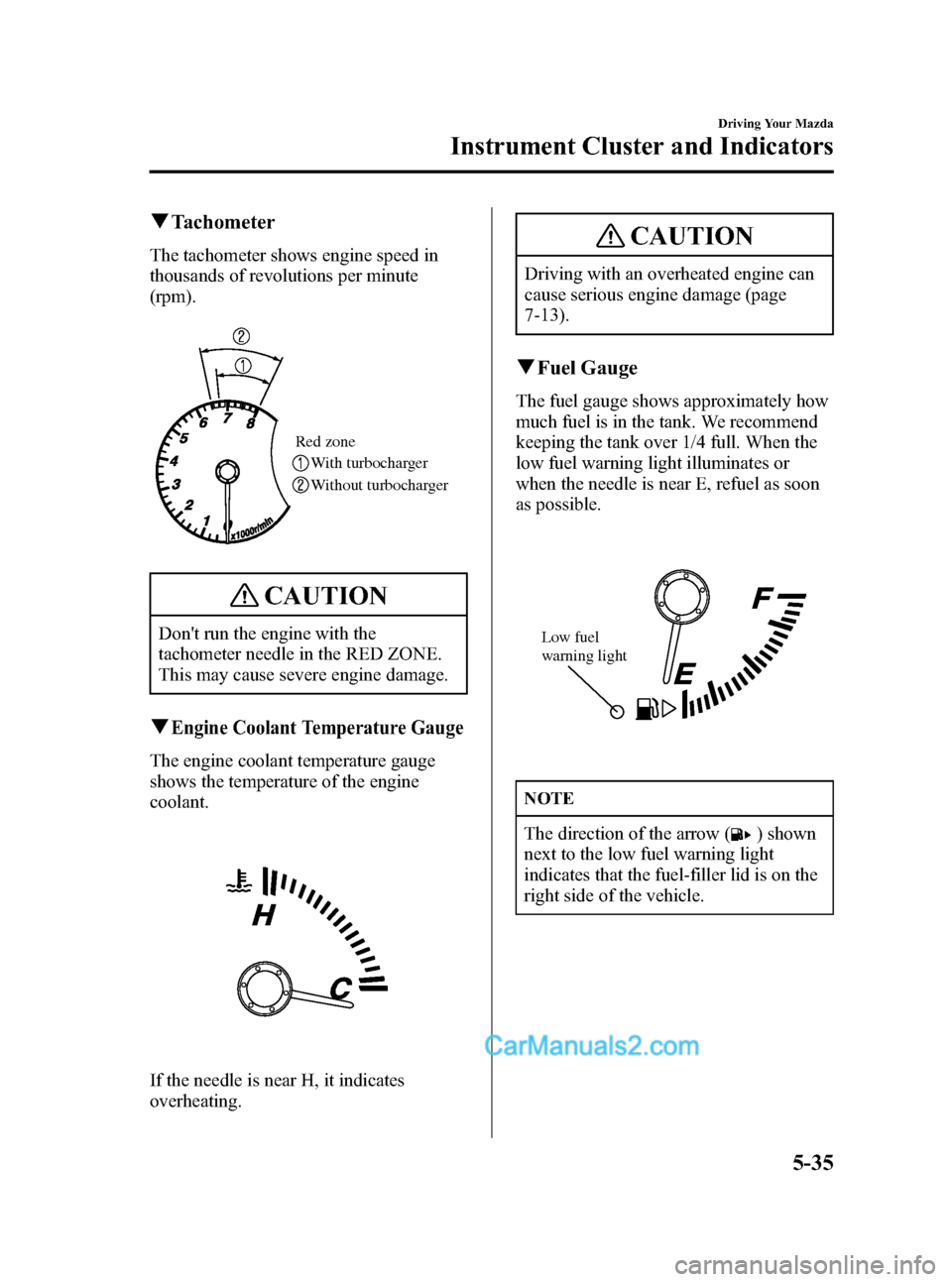
Black plate (157,1)
qTachometer
The tachometer shows engine speed in
thousands of revolutions per minute
(rpm).
Red zone
With turbocharger
Without turbocharger
CAUTION
Don't run the engine with the
tachometer needle in the RED ZONE.
This may cause severe engine damage.
qEngine Coolant Temperature Gauge
The engine coolant temperature gauge
shows the temperature of the engine
coolant.
If the needle is near H, it indicates
overheating.
CAUTION
Driving with an overheated engine can
cause serious engine damage (page
7-13).
qFuel Gauge
The fuel gauge shows approximately how
much fuel is in the tank. We recommend
keeping the tank over 1/4 full. When the
low fuel warning light illuminates or
when the needle is near E, refuel as soon
as possible.
Low fuel
warning light
NOTE
The direction of the arrow () shown
next to the low fuel warning light
indicates that the fuel-filler lid is on the
right side of the vehicle.
Driving Your Mazda
Instrument Cluster and Indicators
5-35
Mazda3_8V66-EA-06F_Edition3 Page157
Wednesday, August 23 2006 11:19 AM
Form No.8V66-EA-06F
Page 265 of 402
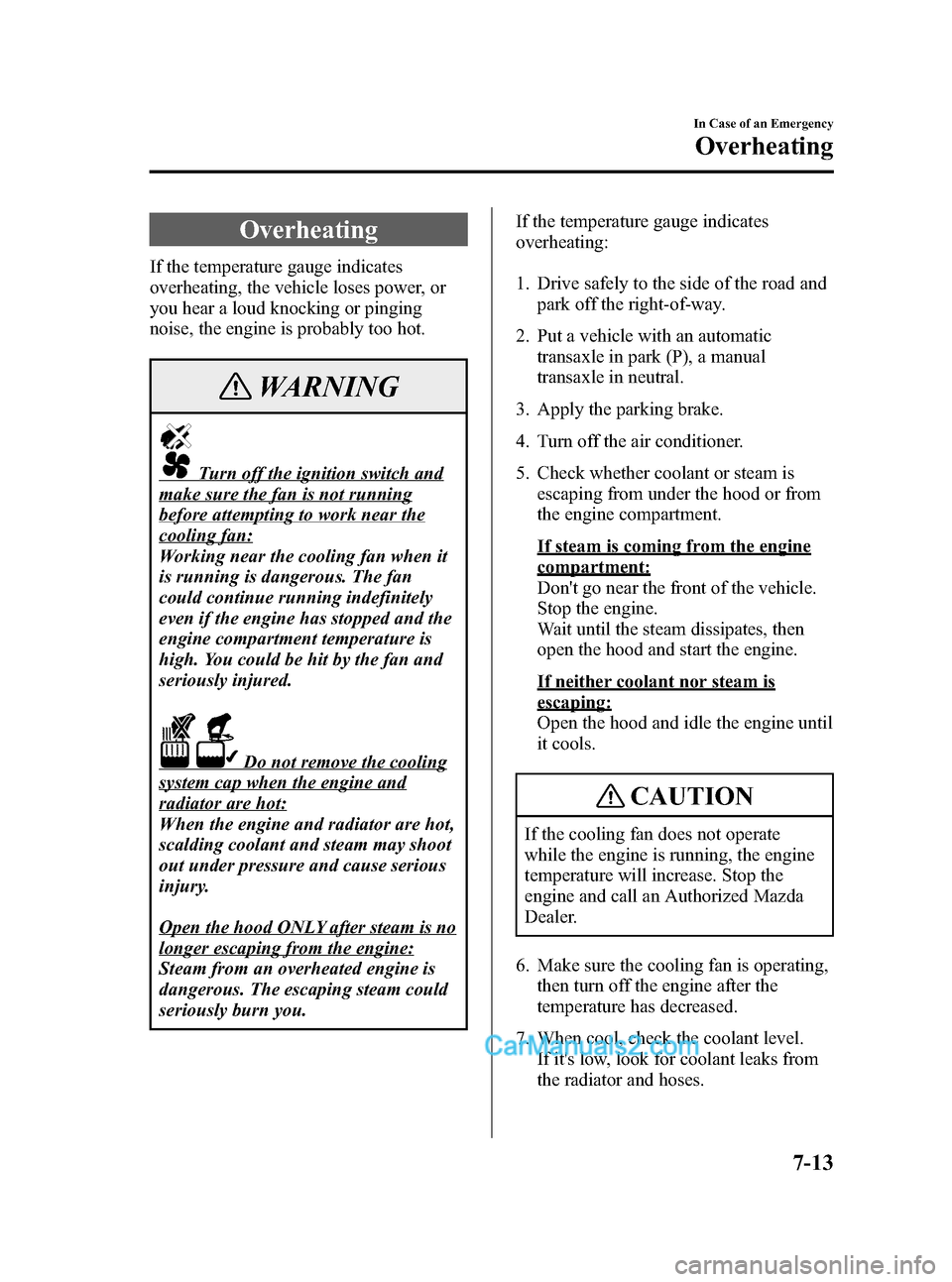
Black plate (265,1)
Overheating
If the temperature gauge indicates
overheating, the vehicle loses power, or
you hear a loud knocking or pinging
noise, the engine is probably too hot.
WARNING
Turn off the ignition switch and
make sure the fan is not running
before attempting to work near the
cooling fan:
Working near the cooling fan when it
is running is dangerous. The fan
could continue running indefinitely
even if the engine has stopped and the
engine compartment temperature is
high. You could be hit by the fan and
seriously injured.
Do not remove the cooling
system cap when the engine and
radiator are hot:
When the engine and radiator are hot,
scalding coolant and steam may shoot
out under pressure and cause serious
injury.
Open the hood ONLY after steam is no
longer escaping from the engine:
Steam from an overheated engine is
dangerous. The escaping steam could
seriously burn you.If the temperature gauge indicates
overheating:
1. Drive safely to the side of the road and
park off the right-of-way.
2. Put a vehicle with an automatic
transaxle in park (P), a manual
transaxle in neutral.
3. Apply the parking brake.
4. Turn off the air conditioner.
5. Check whether coolant or steam is
escaping from under the hood or from
the engine compartment.
If steam is coming from the engine
compartment:
Don't go near the front of the vehicle.
Stop the engine.
Wait until the steam dissipates, then
open the hood and start the engine.
If neither coolant nor steam is
escaping:
Open the hood and idle the engine until
it cools.
CAUTION
If the cooling fan does not operate
while the engine is running, the engine
temperature will increase. Stop the
engine and call an Authorized Mazda
Dealer.
6. Make sure the cooling fan is operating,
then turn off the engine after the
temperature has decreased.
7. When cool, check the coolant level.
If it's low, look for coolant leaks from
the radiator and hoses.
In Case of an Emergency
Overheating
7-13
Mazda3_8V66-EA-06F_Edition3 Page265
Wednesday, August 23 2006 11:21 AM
Form No.8V66-EA-06F
Page 281 of 402
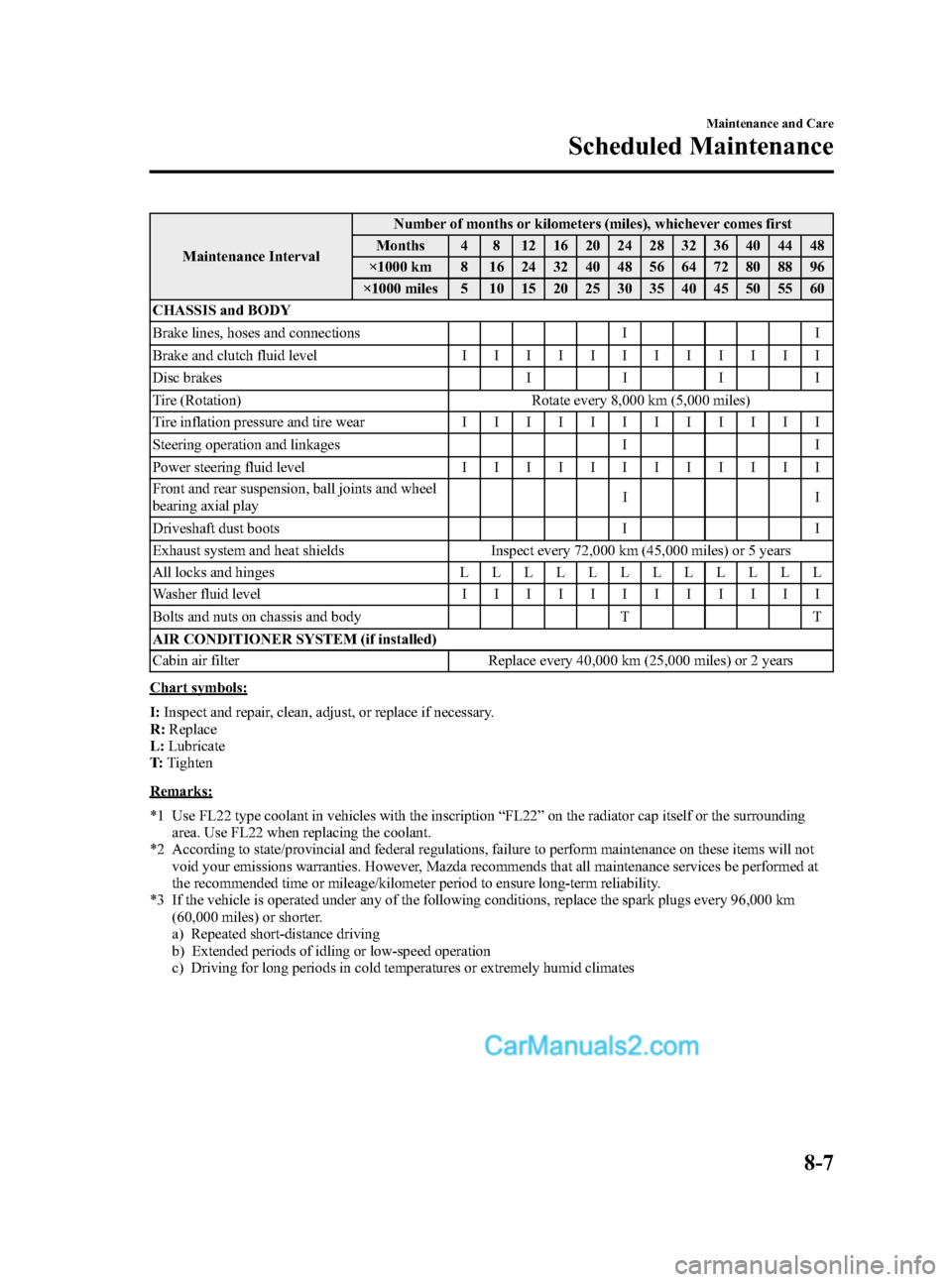
Black plate (281,1)
Maintenance IntervalNumber of months or kilometers (miles), whichever comes first
Months 4 8 12 16 20 24 28 32 36 40 44 48
×1000 km 8 16 24 32 40 48 56 64 72 80 88 96
×1000 miles 5 10 15 20 25 30 35 40 45 50 55 60
CHASSIS and BODY
Brake lines, hoses and connections I I
Brake and clutch fluid levelIIIIIIIIIIII
Disc brakesIIII
Tire (Rotation) Rotate every 8,000 km (5,000 miles)
Tire inflation pressure and tire wearIIIIIIIIIIII
Steering operation and linkages I I
Power steering fluid levelIIIIIIIIIIII
Front and rear suspension, ball joints and wheel
bearing axial playII
Driveshaft dust boots I I
Exhaust system and heat shields Inspect every 72,000 km (45,000 miles) or 5 years
All locks and hingesLLLLLLLLLLLL
Washer fluid levelIIIIIIIIIIII
Bolts and nuts on chassis and body T T
AIR CONDITIONER SYSTEM (if installed)
Cabin air filter Replace every 40,000 km (25,000 miles) or 2 years
Chart symbols:
I:Inspect and repair, clean, adjust, or replace if necessary.
R:Replace
L:Lubricate
T:Tighten
Remarks:
*1 Use FL22 type coolant in vehicles with the inscription“FL22”on the radiator cap itself or the surrounding
area. Use FL22 when replacing the coolant.
*2 According to state/provincial and federal regulations, failure to perform maintenance on these items will not
void your emissions warranties. However, Mazda recommends that all maintenance services be performed at
the recommended time or mileage/kilometer period to ensure long-term reliability.
*3 If the vehicle is operated under any of the following conditions, replace the spark plugs every 96,000 km
(60,000 miles) or shorter.
a) Repeated short-distance driving
b) Extended periods of idling or low-speed operation
c) Driving for long periods in cold temperatures or extremely humid climates
Maintenance and Care
Scheduled Maintenance
8-7
Mazda3_8V66-EA-06F_Edition3 Page281
Wednesday, August 23 2006 11:21 AM
Form No.8V66-EA-06F
Page 295 of 402
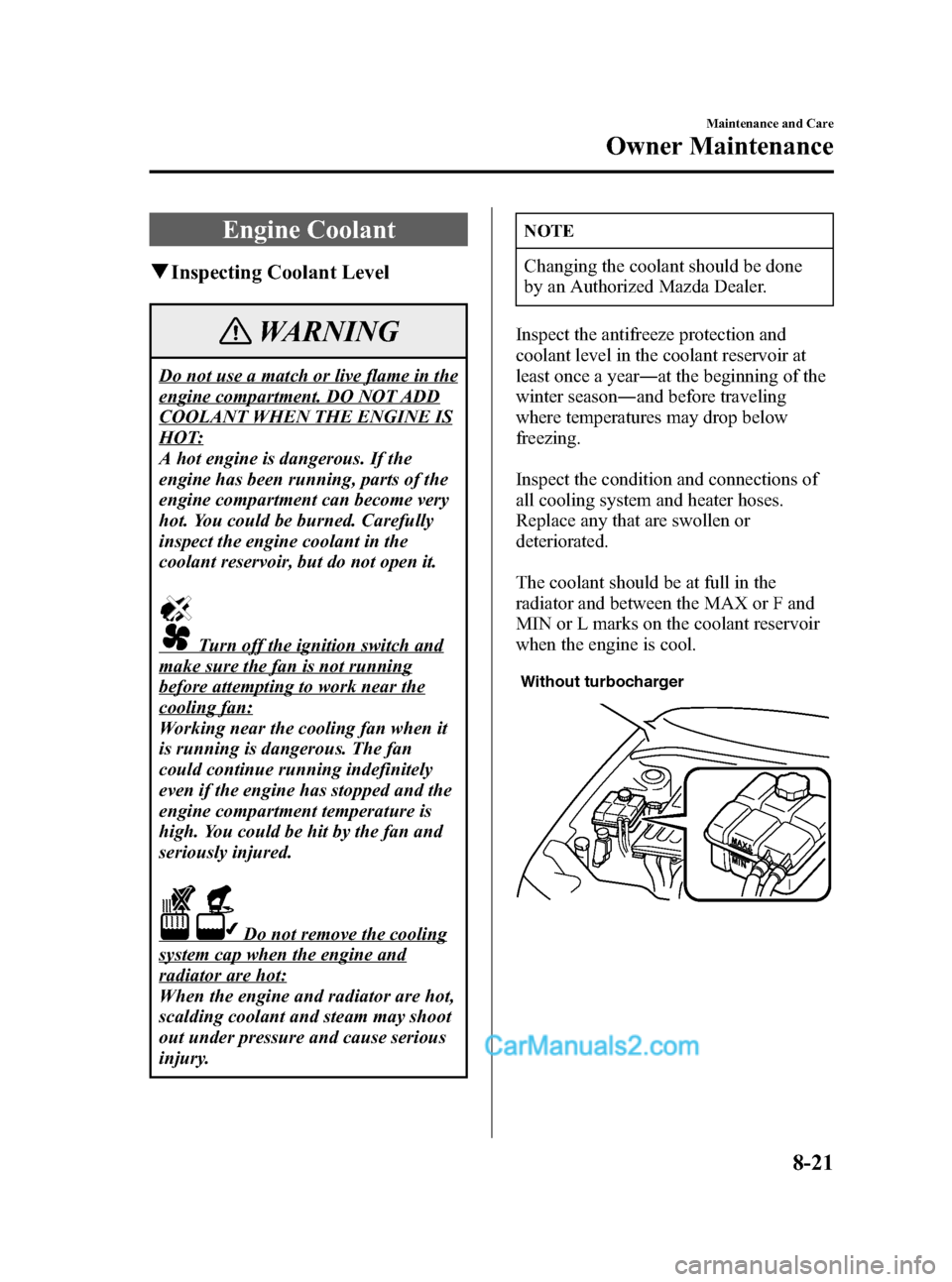
Black plate (295,1)
Engine Coolant
qInspecting Coolant Level
WARNING
Do not use a match or live flame in the
engine compartment. DO NOT ADD
COOLANT WHEN THE ENGINE IS
HOT:
A hot engine is dangerous. If the
engine has been running, parts of the
engine compartment can become very
hot. You could be burned. Carefully
inspect the engine coolant in the
coolant reservoir, but do not open it.
Turn off the ignition switch and
make sure the fan is not running
before attempting to work near the
cooling fan:
Working near the cooling fan when it
is running is dangerous. The fan
could continue running indefinitely
even if the engine has stopped and the
engine compartment temperature is
high. You could be hit by the fan and
seriously injured.
Do not remove the cooling
system cap when the engine and
radiator are hot:
When the engine and radiator are hot,
scalding coolant and steam may shoot
out under pressure and cause serious
injury.
NOTE
Changing the coolant should be done
by an Authorized Mazda Dealer.
Inspect the antifreeze protection and
coolant level in the coolant reservoir at
least once a year―at the beginning of the
winter season―and before traveling
where temperatures may drop below
freezing.
Inspect the condition and connections of
all cooling system and heater hoses.
Replace any that are swollen or
deteriorated.
The coolant should be at full in the
radiator and between the MAX or F and
MIN or L marks on the coolant reservoir
when the engine is cool.
Without turbocharger
Maintenance and Care
Owner Maintenance
8-21
Mazda3_8V66-EA-06F_Edition3 Page295
Wednesday, August 23 2006 11:21 AM
Form No.8V66-EA-06F
Page 389 of 402
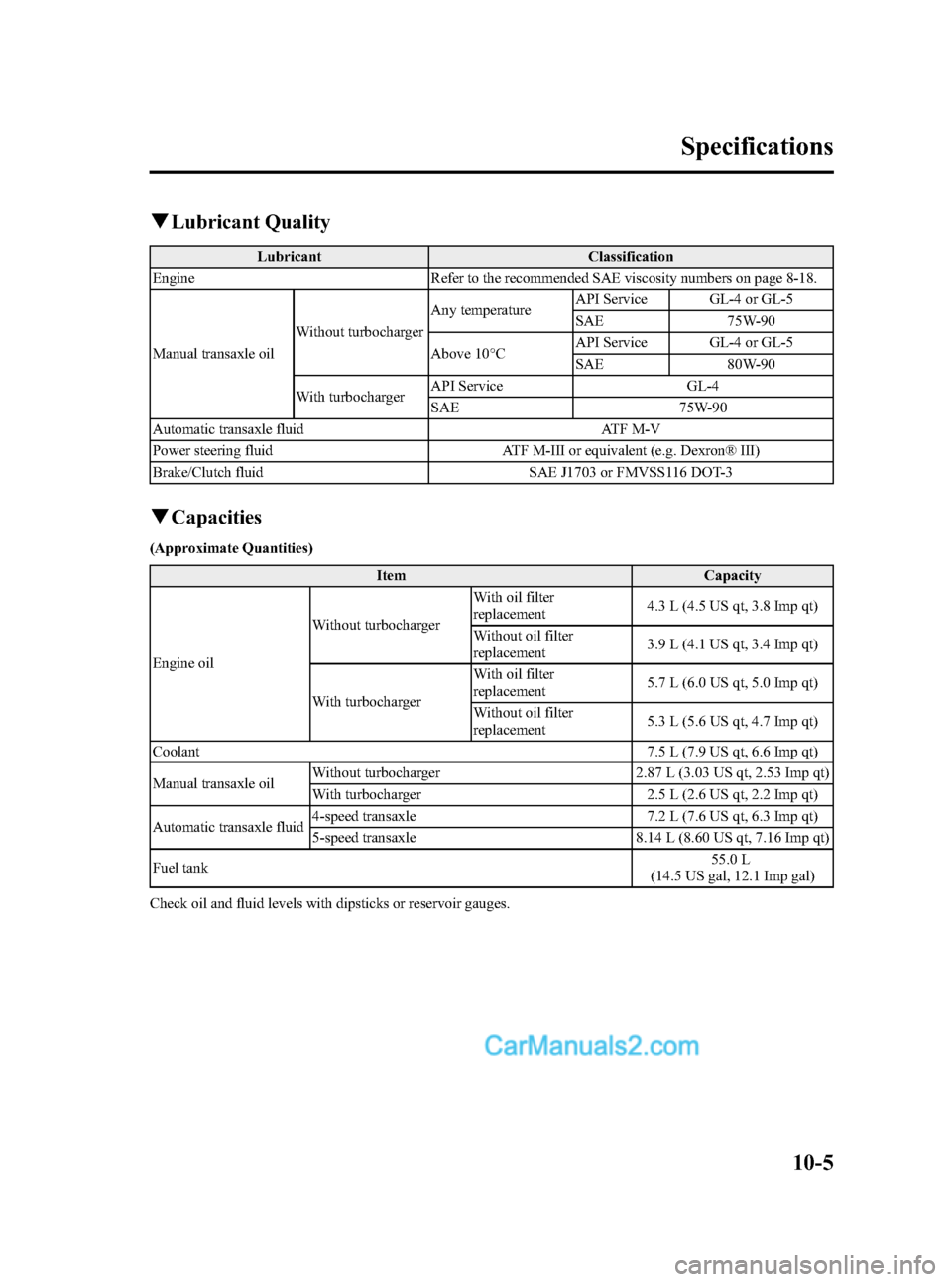
Black plate (389,1)
qLubricant Quality
Lubricant Classification
Engine Refer to the recommended SAE viscosity numbers on page 8-18.
Manual transaxle oilWithout turbochargerAny temperatureAPI Service GL-4 or GL-5
SAE 75W-90
Above 10°CAPI Service GL-4 or GL-5
SAE 80W-90
With turbochargerAPI Service GL-4
SAE 75W-90
Automatic transaxle fluid ATF M-V
Power steering fluid ATF M-III or equivalent (e.g. Dexron® III)
Brake/Clutch fluid SAE J1703 or FMVSS116 DOT-3
qCapacities
(Approximate Quantities)
Item Capacity
Engine oilWithout turbochargerWith oil filter
replacement4.3 L (4.5 US qt, 3.8 Imp qt)
Without oil filter
replacement3.9 L (4.1 US qt, 3.4 Imp qt)
With turbochargerWith oil filter
replacement5.7 L (6.0 US qt, 5.0 Imp qt)
Without oil filter
replacement5.3 L (5.6 US qt, 4.7 Imp qt)
Coolant 7.5 L (7.9 US qt, 6.6 Imp qt)
Manual transaxle oilWithout turbocharger 2.87 L (3.03 US qt, 2.53 Imp qt)
With turbocharger 2.5 L (2.6 US qt, 2.2 Imp qt)
Automatic transaxle fluid4-speed transaxle 7.2 L (7.6 US qt, 6.3 Imp qt)
5-speed transaxle 8.14 L (8.60 US qt, 7.16 Imp qt)
Fuel tank55.0 L
(14.5 US gal, 12.1 Imp gal)
Check oil and fluid levels with dipsticks or reservoir gauges.
Specifications
10-5
Mazda3_8V66-EA-06F_Edition3 Page389
Wednesday, August 23 2006 11:22 AM
Form No.8V66-EA-06F
Page 397 of 402
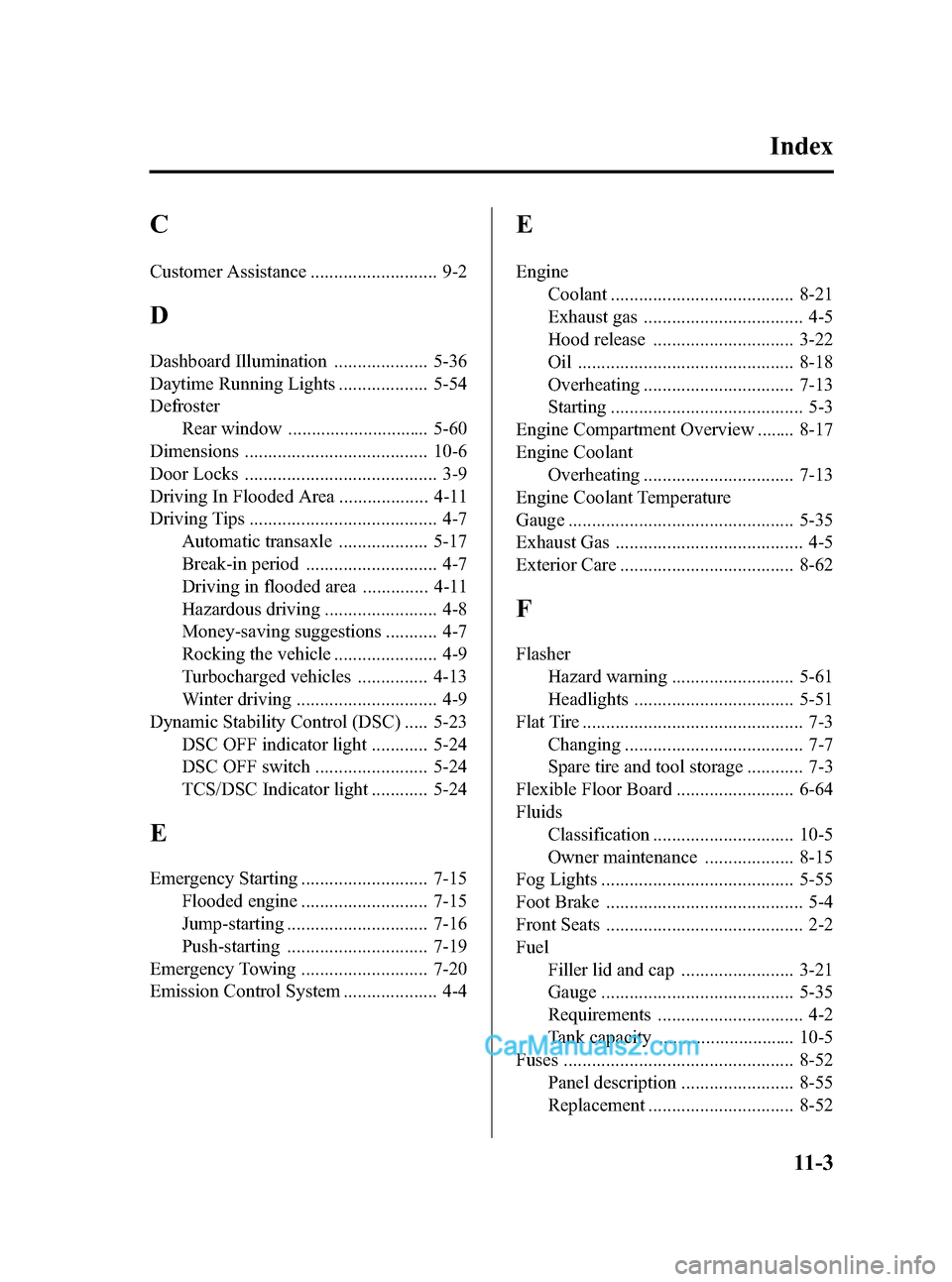
Black plate (397,1)
C
Customer Assistance ........................... 9-2
D
Dashboard Illumination .................... 5-36
Daytime Running Lights ................... 5-54
Defroster
Rear window .............................. 5-60
Dimensions ....................................... 10-6
Door Locks ......................................... 3-9
Driving In Flooded Area ................... 4-11
Driving Tips ........................................ 4-7
Automatic transaxle ................... 5-17
Break-in period ............................ 4-7
Driving in flooded area .............. 4-11
Hazardous driving ........................ 4-8
Money-saving suggestions ........... 4-7
Rocking the vehicle ...................... 4-9
Turbocharged vehicles ............... 4-13
Winter driving .............................. 4-9
Dynamic Stability Control (DSC) ..... 5-23
DSC OFF indicator light ............ 5-24
DSC OFF switch ........................ 5-24
TCS/DSC Indicator light ............ 5-24
E
Emergency Starting ........................... 7-15
Flooded engine ........................... 7-15
Jump-starting .............................. 7-16
Push-starting .............................. 7-19
Emergency Towing ........................... 7-20
Emission Control System .................... 4-4
E
Engine
Coolant ....................................... 8-21
Exhaust gas .................................. 4-5
Hood release .............................. 3-22
Oil .............................................. 8-18
Overheating ................................ 7-13
Starting ......................................... 5-3
Engine Compartment Overview ........ 8-17
Engine Coolant
Overheating ................................ 7-13
Engine Coolant Temperature
Gauge ................................................ 5-35
Exhaust Gas ........................................ 4-5
Exterior Care ..................................... 8-62
F
Flasher
Hazard warning .......................... 5-61
Headlights .................................. 5-51
Flat Tire ............................................... 7-3
Changing ...................................... 7-7
Spare tire and tool storage ............ 7-3
Flexible Floor Board ......................... 6-64
Fluids
Classification .............................. 10-5
Owner maintenance ................... 8-15
Fog Lights ......................................... 5-55
Foot Brake .......................................... 5-4
Front Seats .......................................... 2-2
Fuel
Filler lid and cap ........................ 3-21
Gauge ......................................... 5-35
Requirements ............................... 4-2
Tank capacity ............................. 10-5
Fuses ................................................. 8-52
Panel description ........................ 8-55
Replacement ............................... 8-52
Index
11-3
Mazda3_8V66-EA-06F_Edition3 Page397
Wednesday, August 23 2006 11:22 AM
Form No.8V66-EA-06F